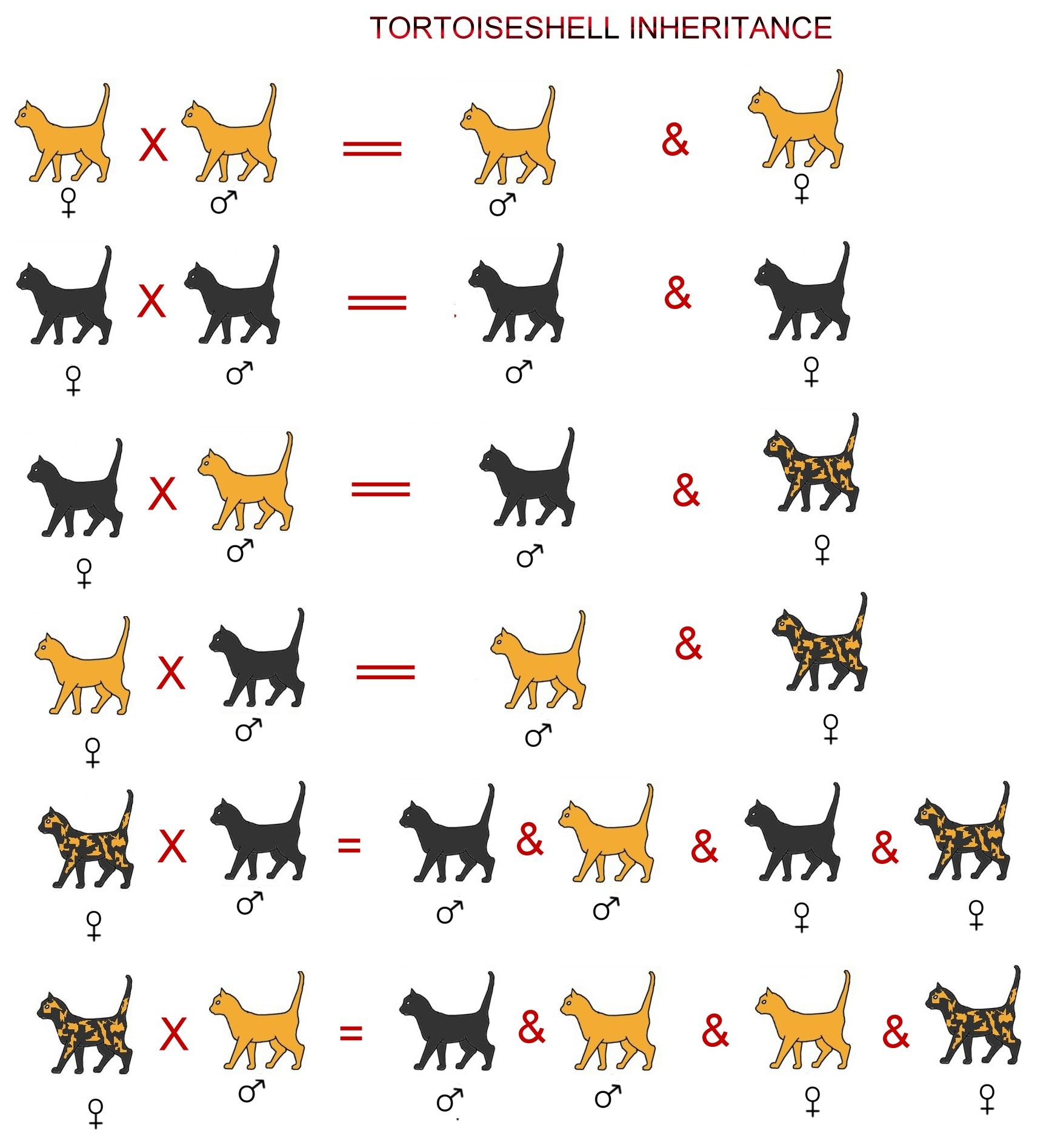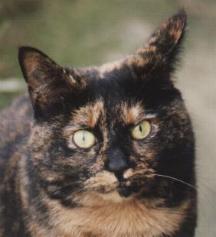
TORTOISESHELL AND TRI-COLOUR CATS
Because of the way tortoiseshell is inherited, most tortoiseshell and calico (tortie-and-white) cats are female. TMale tortoiseshell cats are caused by genetic aberration or development abnormalities in the foetus which are discussed in "
Mosaicism, Tortie Tomcats, Genetically Impossible Kittens and Gender Anomalies". This article only considers normal tortoiseshell cats. Jean Bungartz, a German writer in the 1890s, referred to tortoiseshell-and-white cats as "Spanish cats" but said it was hard to explain why they got the name as they were not restricted to the Pyrenean peninsula.HOW TORTOISESHELL PATTERNS OCCUR

The ginger colour of cats (known as "yellow", "orange" or "red") is caused by the "O" gene which changes black pigment into a reddish pigment. The O gene is carried on the X chromosome. A normal male cat has XY genetic makeup; he only needs to inherit one O gene for him to be a ginger cat. A normal female is XX genetic makeup and must inherit two O genes to be a ginger cat. If she inherits only one O gene, she will be tortoiseshell. The O gene is called a sex-linked gene because it is carried on a sex chromosome. Tortoiseshell cats are therefore heterozygous (not true-breeding) for red colour. The actual formation of red and black patches in a female with only one O gene is through a process known as X-chromosome inactivation (described in X Chromosome Inactivation and "Split Face" Torties). Some cells randomly activate the X chromosome carrying the O gene while others activate the other X chromosome. This only shows up visibly in pigment-producing skin cells. This occurs early on in the embryo and as skin cells multiply, they form patches. The skin is a mosaic of cells where some have the O gene active (making ginger pigment) and some do not (making black pigment). This can only happen in cats with two X chromosomes. Because male cats only inherit one X chromosome this is active in all skin cells.
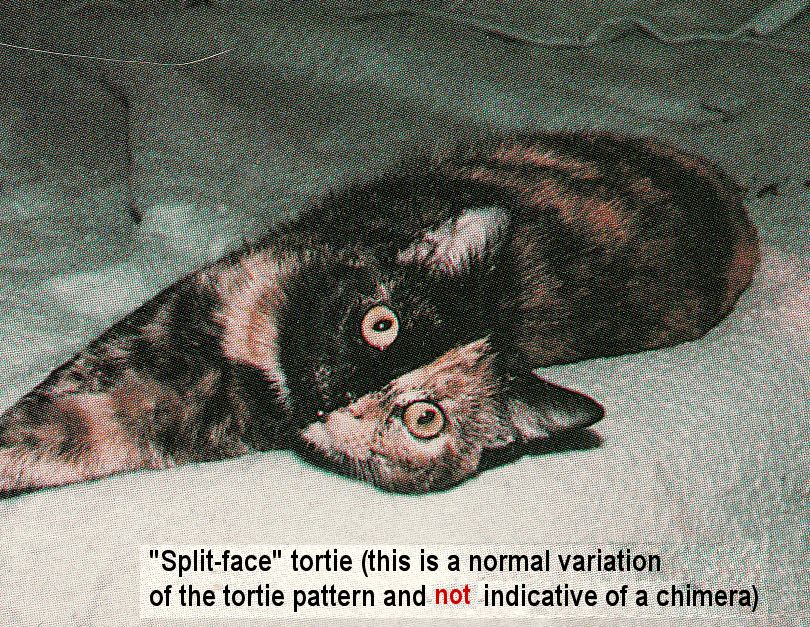
To be accurate, O = orange and o = "non-orange" meaning that o allows whatever colour is carried on other chromosomes to be displayed (black, blue, chocolate etc). The O gene converts normal black/chocolate/cinnamon etc pigment into red pigment. For the sake of simplicity, this article refers to o as "black" since that is the most commonly seen non-orange colour in tortoiseshell cats.
There are two main theories regarding brindled torties and patched torties. One (the "early/late inactivation theory") suggests that the time at which X chromosome inctivation occurs during foetal growth determines whether the cat has well defined patches or more intermingled black and orange hairs. Skin cells multiply during growth and spread out across the skin; as the embryo grows the skin cells multiply. If inactivation occurs early, each pigment cell has space to multiply into, creating distinct patches of colour. If it occurs later, the patches are smaller; some being" will be no larger than a single hair! The other theory regarding brindling and patching (the "migration theory") is that intermingled torties occur when there are more pigment producing cells produced from the neural crest (which becomes the back and spine area). The cells are assumed to have undergone X chromosome deactivation before migration. The migrating cells carry either O (red) or o (black) and they migrate at the same rate into their final positions. Where there are many pigment producing cells, there is more competition (imagine cells jockeying for position on the skin) and they become intermingled. Where there are fewer pigment producing cells, each cell has room to grow into patches of colour (imagine plants forming clumps in a flower border).
All Red Cats Are Red Tabbies? All red cats, even genetically solid colour cats, appear red tabby because the non-agouti gene that turns a tabby into a self/solid colour) does not affect red pigment. Polygenes (modifiers) control the intensity of colour and contrast between markings and background colour. In genetically solid colour red cats, selective breeding can reduce the tabby markings to produce a cat that looks solid red by breeding from cats with "low contrast", but faint markings may be discernible on the tail, legs and forehead and a darker region along the spine.
All female mammals have X-inactivation. In women, there is an uncommon condition called anhidrotic ectodermal dysplasia caused by a faulty gene on the X chromosome. The faulty gene reduces the number of sweat glands per square centimetre on the skin. In women who inherit one normal gene and one faulty gene; their skin may be divided into hundreds of small patches which only become visible when they sweat. The normal patches of skin sweat normally, but the patches derived from cells with a faulty gene don't.
TORTOISESHELL-AND-WHITE (CALICO) CATS
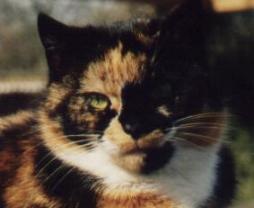
The white patches in tortie-and-white (tricolour, calico) cats is caused by the piebald spotting gene discussed in Beautiful Bicolours. This is a dominant gene with very variable expression ranging from nearly all white to nearly all coloured with only a few white hairs. The gene affects the embryo cells which will become pigment-producing skin cells. These cells are initially formed along the "neural crest" (embryo's backbone area) and migrate across the body during formation of the skin. Where these pigment producing cells fail to get in position before the skin is fully formed, there are areas of skin which lack pigment producing cells; usually the areas furthest from the cat's backbone - paws, belly, chest and chin - as these areas take longest to reach. One effect of white spotting in tortoiseshell cats is to change the pattern from intermingled to patched. Tortie cats with little or no white tend to have brindled coats. However, the more white there is, the more the black and white will also be separated out into patches instead of being intermingled. The phenomenon of tortie-and-white cats having better defined patches of colour is familiar to most cat lovers.

If the "migration theory" is correct, cells which activate O (red) and those which activate o (black) migrate at the same speed, leading to an intermingled. If the embryos also inherit the gene for white spotting, the fur develops as patches of colour. The bigger the white areas, the bigger and better defined the separate patches of black and red. The presence of the white spotting means fewer pigment producing cells and less competition between them as they migrate into position. One or two cells reach an area and these multiply in situ to form a patch of colour (a clonal patch).
TORTOISESHELL TABBIES, SILVER/SMOKE TORTIES AND COLOURPOINT TORTIES
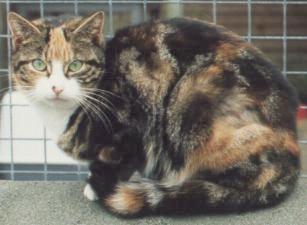
Where a tortoiseshell cat has the non-agouti gene it appears to have solid patches of colour, but because red pigment deposition is not affected by the non-agouti gene, there will be some degree of tabby marking remains visible in the red areas. If a tortoiseshell cat has the agouti gene instead, the tabby markings will be visible in all of the coloured patches: the non-red colour will be tabby instead of solid colour. These are tortoiseshell-tabbies (patched tabbies or (in the US) torbies). The tabby pattern may be classic (blotched), mackerel or spotted. In a usual tortoiseshell, the black patches become brown tabby (i.e.. black markings on brown background), the red patches become more obviously red tabby (red patches on paler red background). Patched tabbies occur in other tortie colours e.g. blue-cream patched tabby.
Tortoiseshell can also be combined with the inhibitor (silver) gene to produce tortoiseshell markings on a silvery background e.g. black-silver (black markings on pale grey) and red-silver patches. In agouti (tabby marked) cats this gives tipped and shaded torties. In non-agouti cats it gives tortie smokes. in all cases, the tortoiseshell colours are restricted to the hair-tips instead of going all the way to the root, giving the effect of a shimmering tortie pattern on a pale undercoat.
In colourpoint cats, only the points (legs, tail and face) show as tortoiseshell and because the gene causing the colouorpoint pattern turns black into dark brown, the tortoiseshell pattern will contain dark brown rather than jet black.
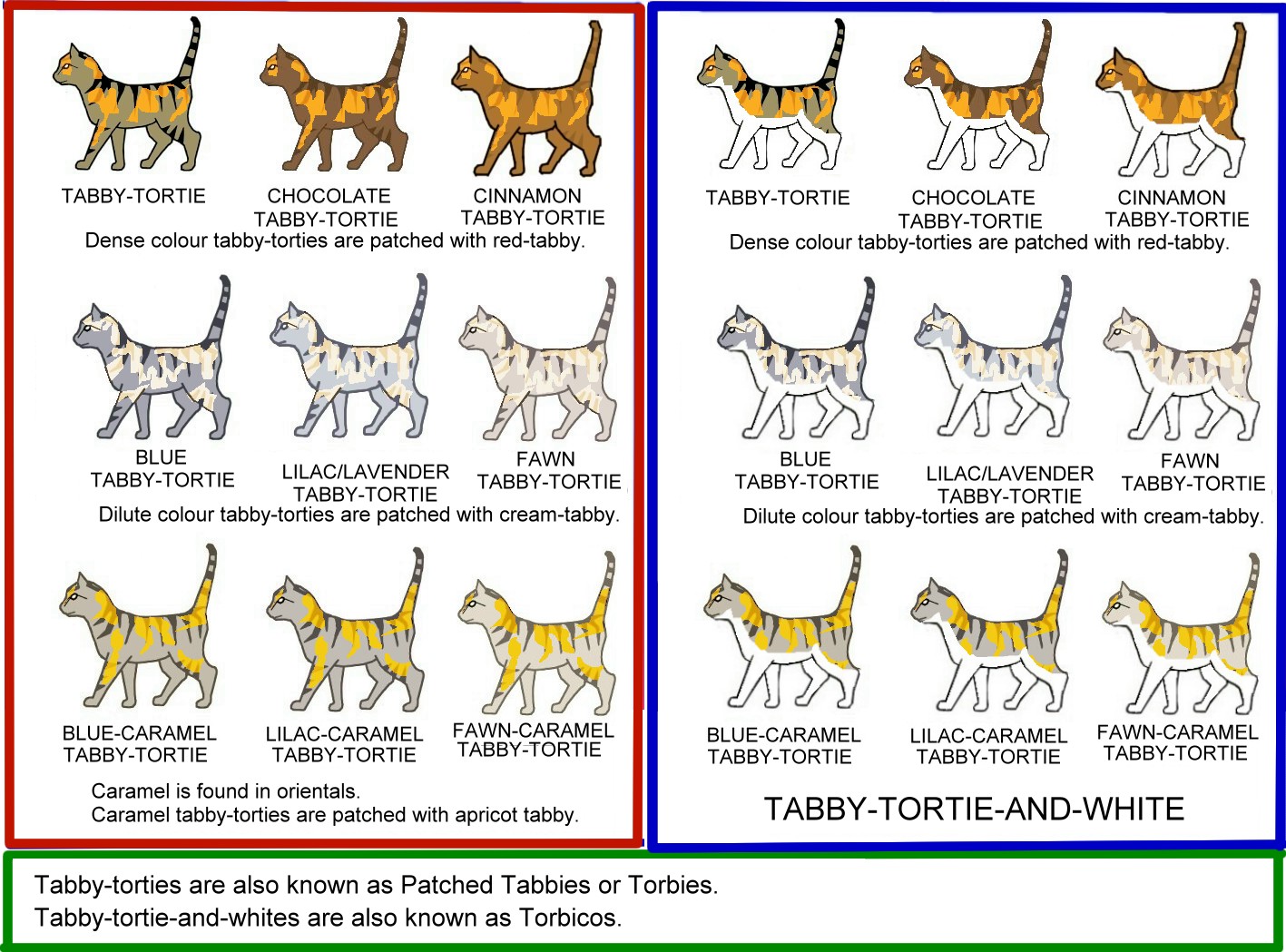
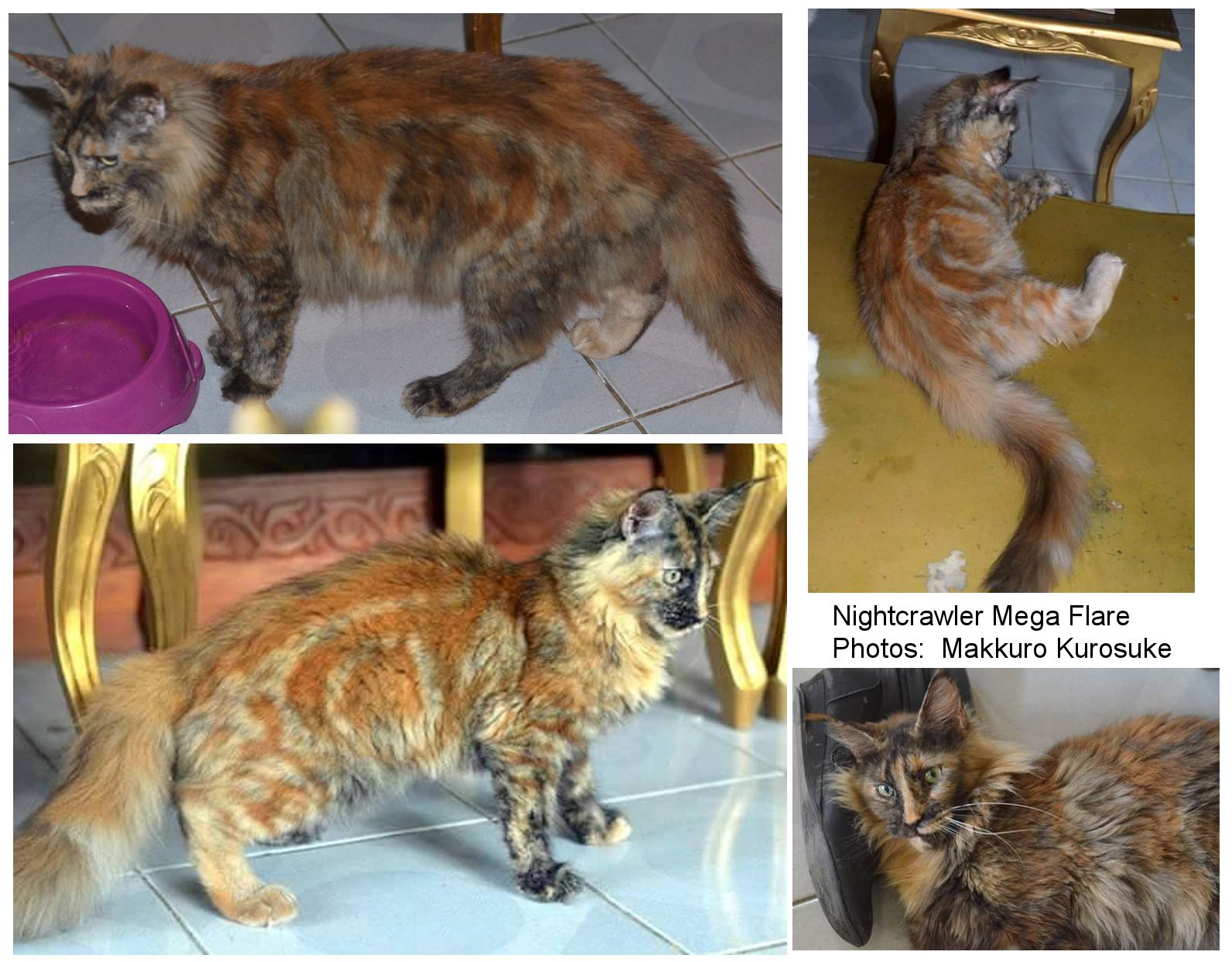
This is Nightcrawler Mega Flare ("MegMeg"), a tortoiseshell Maine Coon belonging to Makkuro Kurosuke in Brunei. Her sire is solid black and her dam is a blue tortie smoke with white. The pictures show how the O gene does not let the non-agouti gene work ao the red colour always shows some degree of pattern even if the cat is genetically non-agouti (solid colour). Because of this, in the red areas, Mega shows the classic tabby pattern. It's a visually stunning effect.
P>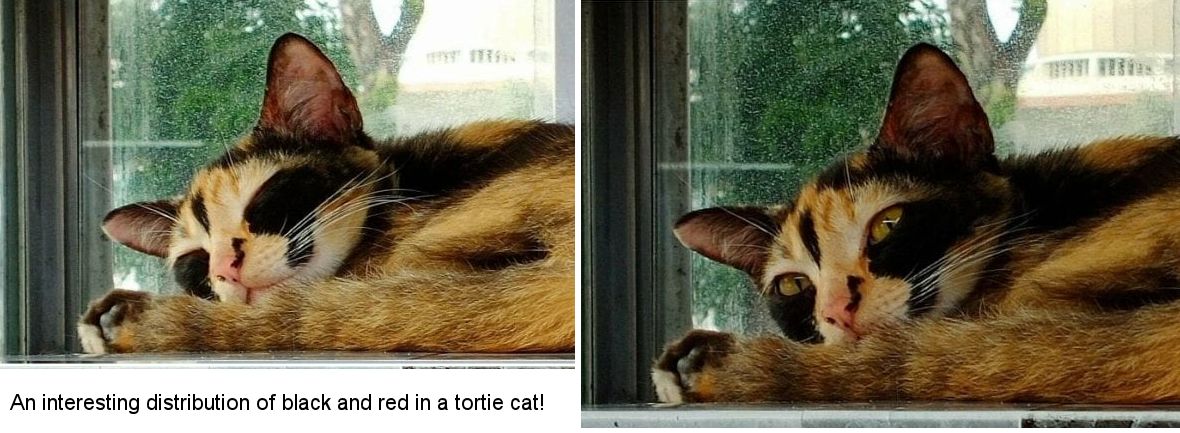
TORTIE ABYSSINIANS AND TORTIE TICKED TABBIES
The true sex-linked red Abyssinian is bright orange with a red tail tip. In Abyssinians, non-sex-linked red ("sorrel" - genetically cinnamon) does not produce tortoiseshells. The Abyssinian pattern is a form of tabby called ticked tabby, and is described in Striped and Spotted Cats. The ticked pattern changes the visual appearance of the cat's colour. Abyssinian "non-sex-linked red"/"sorrel" appears as a reddish-brown due to the ticked pattern of the hair. Chocolate Abyssinians appear a deeper red that sorrel and have a darker tail tip. It is important for breeders to know whether they have sex-linked red or non-sex-linked red as this will affect the breeding program. Where there is sex-linked red, there can also be tortoiseshells. Tortie Abyssinians occur, but since the breed does not permit white, these are always intermingled. The combination of intermingled colours and ticking can make it difficult to determine whether a female is tortie or not just from visual inspection. Sometimes a female Abyssinian is only revealed as genetically tortie when she produces a mix of red and black kittens!
Strictly speaking, because Abyssinian is a tabby pattern, the tortie versions should be termed ticked tabby torties rather than ticked torties. This photo shows Harley (Harlequin) and Spot (provided by owner Lizzi) who were resuced as feral kittens. Harlequin is a ticked torbies, while littermates Spot is ticked tabby with white, and Blaze and Mr Grey are mackerel tabbies with white. The two mackerel tabbies are quite lightly marked on a ticked background and show some rufousing (red tints).
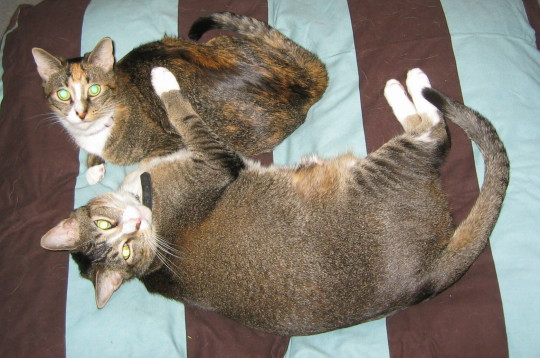
Ticked tabby also occurs in randombred cats, in which case there may also be white markings, resulting in "ticked tortie tabby and white" (ticked calico). The photo shows part-Abyssinian tortoiseshell ticked tabby kittens with white.
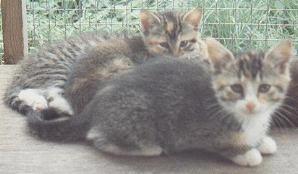
"DAPPLED" TORTOISESHELLS
In June 2022, Kathryn Stokey had an interesting Tennessee Rex kitten. She is blue tortoiseshell, her father is solid blue and her mother is solid cream (DNA tested non agouti). Her initial kitten coat comprised intermingled blue and cream hairs without distinct patches. After moulting, the kitten's fur has formed perfect cream spots on a blue background, something I'd never seen previously.
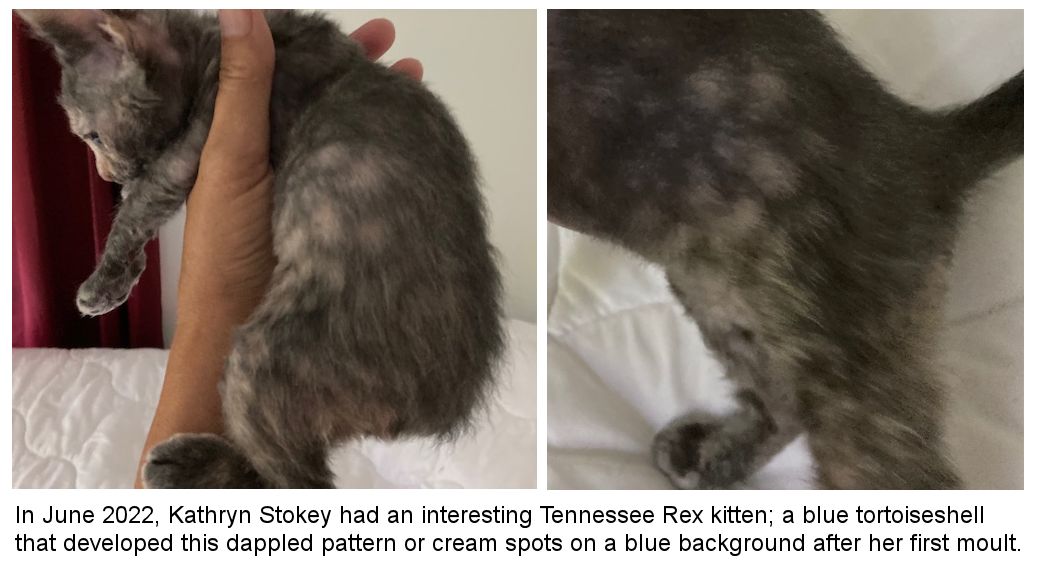
In 2024, Vikky Treby also shared a photo of a "dappled" tortie.
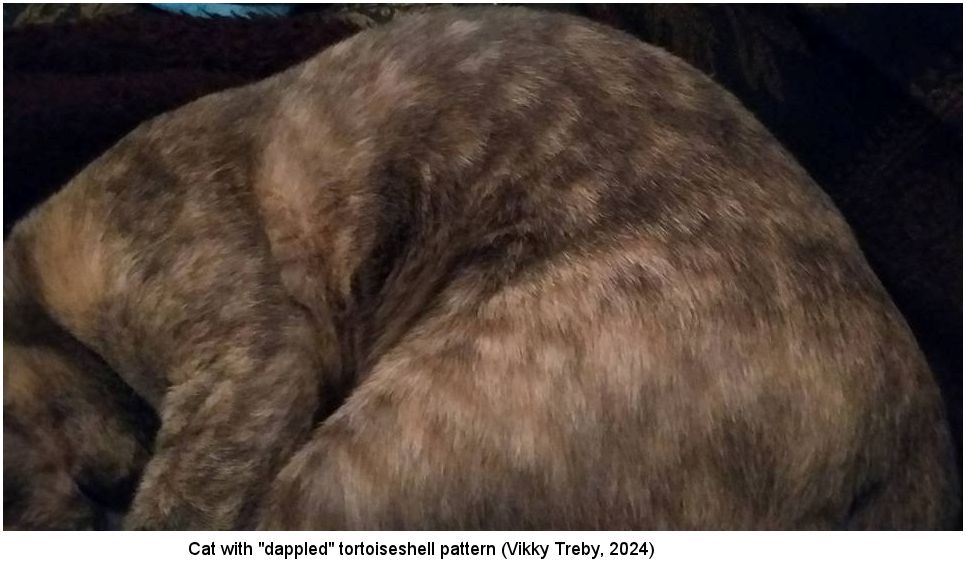
Also in 2024, Allyson Talbott shared a photo of a "dappled" tortie named Cassie, who has red dapples on a black background.
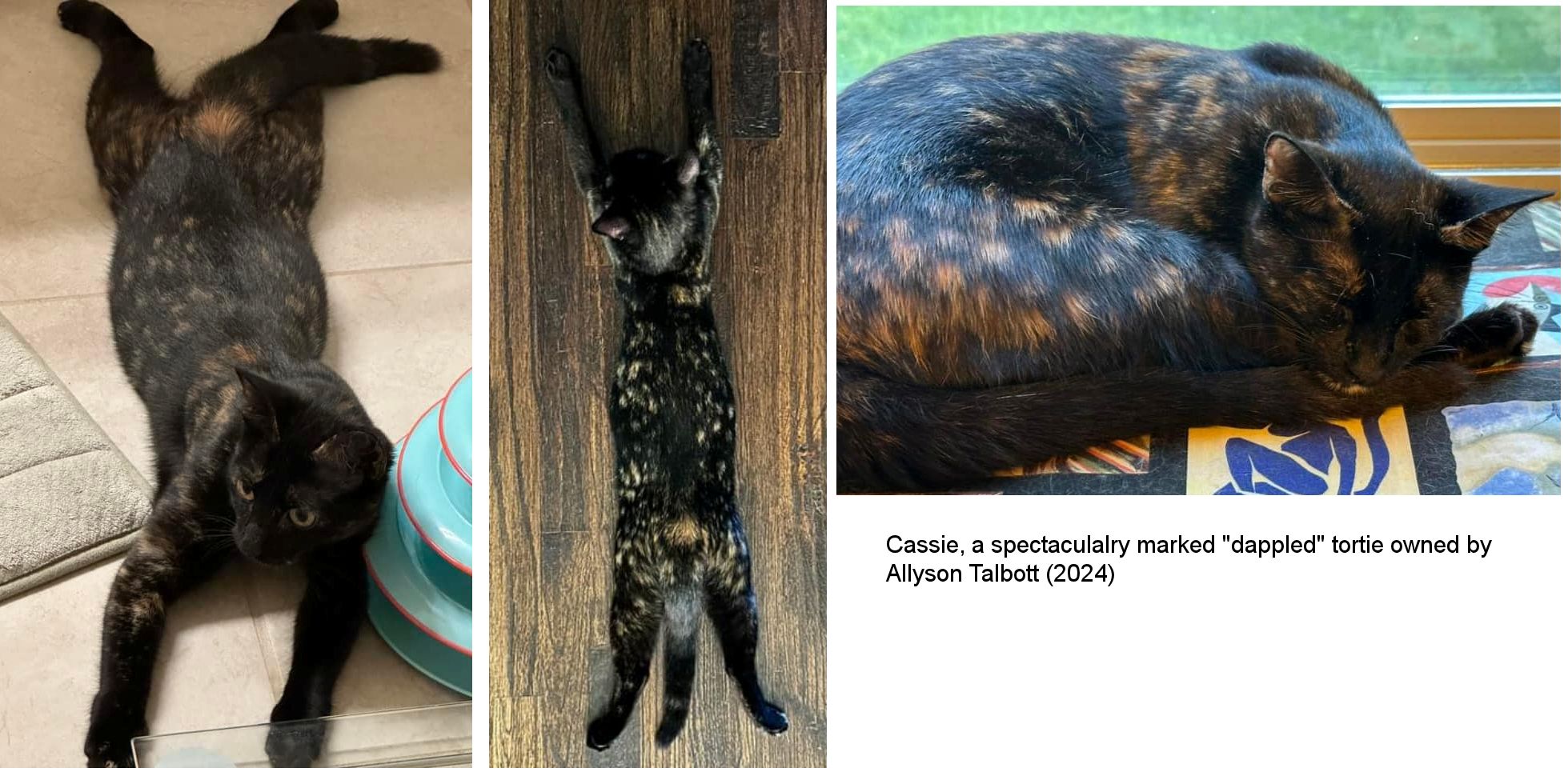
DIFFERENT TORTOISESHELL COLOURS
The basic tortoiseshell combination is black and red. The addition of the dilution gene gives rise to the other tortoiseshells combinations. In Burmese cats, where there is a different dilution gene at work, diluting black into brown. Caramel colours (a modifier of dilute colours) may be visually indistinguishable from other colours, and only known to be caramel based on the cat's pedigree. The table is are based on solid colour cats.
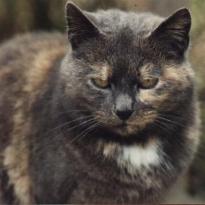
|
NON-DILUTE COLOUR |
DILUTE VERSION |
CARAMEL (DILUTE MODIFIER) VERSION |
|
Tortoiseshell |
Blue-Cream Tortoiseshell |
Caramel/Apricot |
|
Cinnamon Tortoiseshell |
Fawn Tortoiseshell: |
Caramel/Apricot |
|
Chocolate (Chestnut) Tortoiseshell |
Lilac (Lavender) Tortoiseshell: |
Taupe/Apricot |
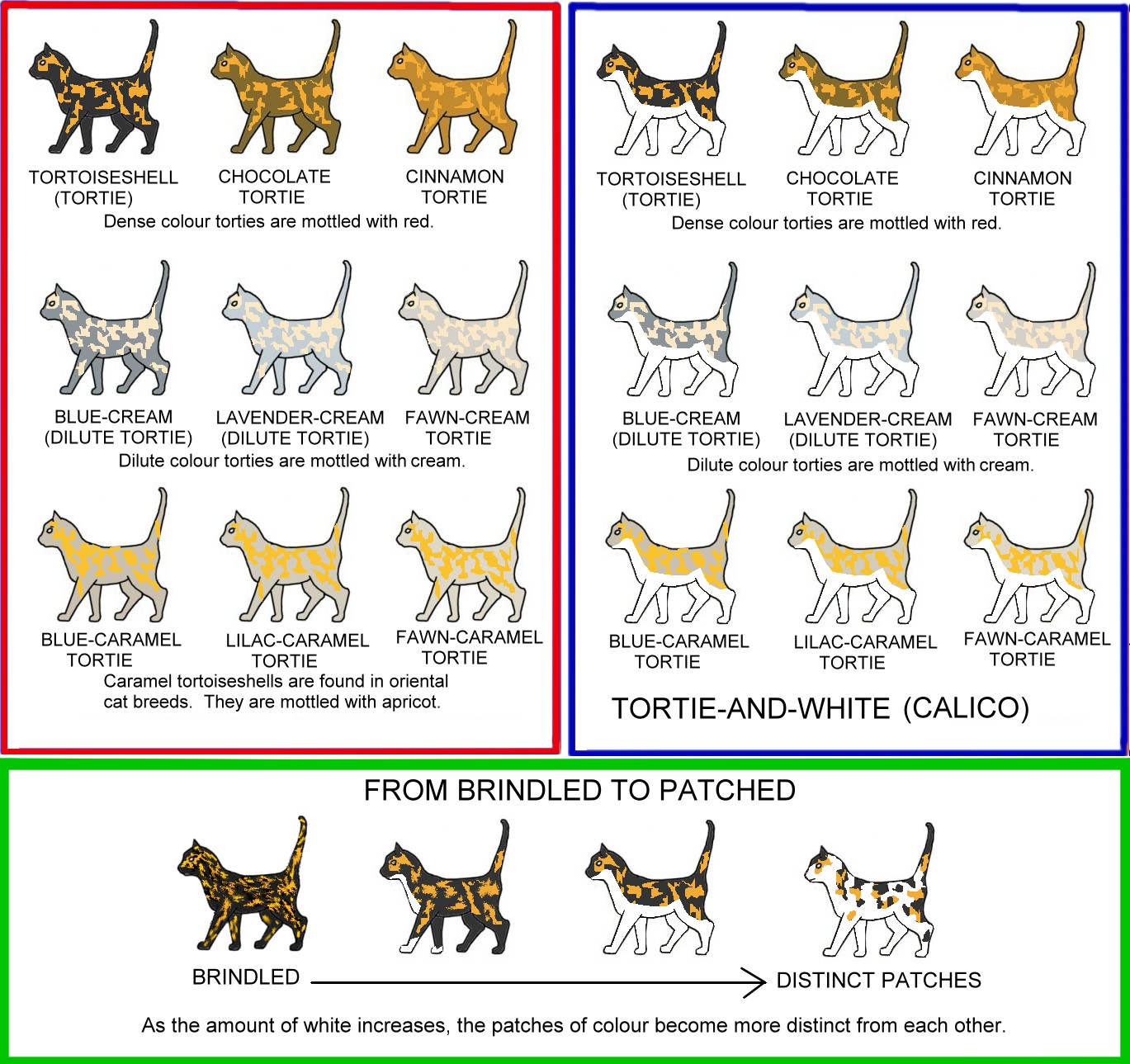
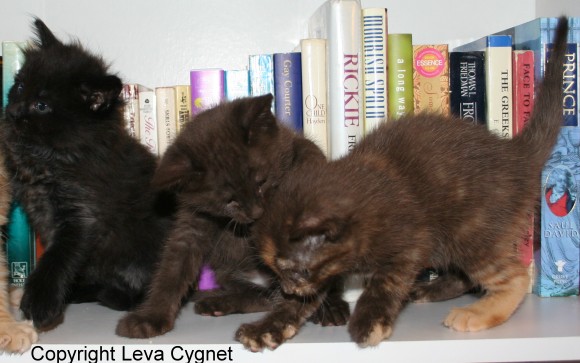
Above are black (smoke), solid chocolate and chocolate tortie kittens. The black is shown for colour comparison. Chocolate and choc-tortie are more common in pedigree cats than in randombreds, but these kittens were born to non-pedigree parents. Photo courtesy of Leva Cygnet.
BREEDING TORTOISESHELLS
In order to produce tortoiseshell kittens, at least one of the parents must carry the O gene. Red male and red female only produce red kittens. The combinations which produce tortoiseshell kittens are red male and non-red female, red female and non-red male. The following can also produce tortoiseshell kittens: tortie female and non-red male, tortie female and red male. It also depends on some kittens being female.
|
Parents |
Kittens |
||
|
Female |
Male |
Males |
Females |
|
Red |
Red | Red | Red |
| Black | Red | Black | Tortie |
| Tortie | Red | Red | Red |
|
|
|
Black | Tortie |
| Tortie | Black | Red | Tortie |
|
|
|
Black | Black |
| Red | Black | Red | Tortie |
| Black | Black | Black | Black |
This is what is happening when a tortoiseshell female is mated to either a red or a black male. Because a tortie female is heterozygous, she can pass on either the gene for red or the gene for non-red (black). The colour of the kittens depends on whether they are male or female and what gene, if any, they inherit from the male.
| GENES FROM RED MALE |
GENES FROM TORTOISESHELL FEMALE |
|
GENES FROM BLACK MALE | GENES FROM TORTOISESHELL FEMALE | ||
|
|
O (red) | o (non-red [black]) |
|
|
O (red) | o (non-red [black]) |
|
O (red) X chromosome |
OO
Red female |
Oo
Tortie female |
|
o (non-red [black]) X chromosome |
Oo
Tortie female |
oo
Black female |
| No gene (Y chromosome) |
O-
Red male |
o-
Black male |
|
No gene (Y chromosome) |
O-
Red male |
o-
Black male |
Because other conditions can give the impression of being tortoiseshell, some matings which theoretically have a high probability of producing tortie kittens will only ever produce red or black kittens. At the other extreme, a genetically tortoiseshell cat may appear to be solid ginger or solid black because of the way the X chromosomes activated - these cats will produce unexpected tortie kittens in appropriate matings.
CLONING TORTOISESHELLS
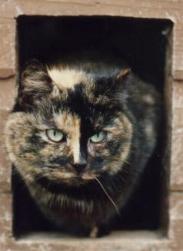
If you clone a tortoiseshell cat you will end up with a cat of one or other of the constituent colours and not a tortoiseshell clone. If you clone a red/black tortoiseshell, the clone will be either red (ginger) or black. DNA tests on the tabby-and-white cloned kitten ("Cc") proved that she was a clone of her tortie-and-white genetic mother (the cat whose cell was used to create Cc). The pattern of pigmentation in multicoloured animals is the result of genetic factors combined with developmental factors within the womb. This means bad news for owners who want an exact replica of a tortoiseshell or calico cat. Why isn't Cc also tortie-and-white? The answer is due to 'X-linked Inactivation' mentioned previously.
Regardless of which cell was used to produce Cc, because that cell is already an adult cells, one or other of the cell's X chromosomes had already been inactivated while the donor cat was an embryo. Cc had an equal chance of being orange-tabby-and-white or black-tabby-and-white, but would never be tortie-tabby-and-white. Unless a way can be found to undo X inactivation, owners wishing to clone a tortoiseshell cat will have to settle for a cat of a different colour entirely. If X inactivation can be reset in a donor cell, the inactivation in the new embryo is a random process so the clone will have the right colours, but not in the same places as the donor cat - it may have well-defined patches of colour while the donor cat was thoroughly intermingled.
TRI-COLOUR BENGALS AND ANOMALOUS TRI-COLOURS
Despite the term "tri-colour" (which is not used as often these days), tri-colour Bengals are not tortoiseshell cats.In the Bengal breed, tri-colour refers to a cat with black rosettes on a golden brown background where the centre of the rosette is a darker version of the background colour. Genuine tortoiseshell Bengal variants have occurred during breed development, but it is not an accepted colour.
A number of anomalous tricolours are discussed in Mosaicism, Tortie Tomcats, Genetically Impossible Kittens and Gender Anomalies. These include a white, black and grey tricolour and a white, red and grey tricolour.
